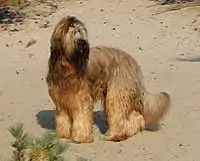Briard
The Briard /briːɑːrd/ is an ancient breed of large herding dog, originally from France. The breed became popular after the Paris dog show of 1863, after having been fixed with crosses with the Beauceron and the Barbet.
| Briard | |||||||||||||||||||||||||||||
|---|---|---|---|---|---|---|---|---|---|---|---|---|---|---|---|---|---|---|---|---|---|---|---|---|---|---|---|---|---|
 Briard | |||||||||||||||||||||||||||||
| Other names | Berger de Brie Berger Briard | ||||||||||||||||||||||||||||
| Origin | France | ||||||||||||||||||||||||||||
| |||||||||||||||||||||||||||||
| |||||||||||||||||||||||||||||
| Dog (domestic dog) | |||||||||||||||||||||||||||||
History
They were originally bred to herd and guard flocks of sheep, making the Briard different from those breeds that only guard and those that only herd. The breeds that just herd are often smaller in size, agile, and swift of foot. Those breeds that just guard are usually larger and heavier. Briards were used in all types of herding situations, having the ability to learn many commands and fulfill the jobs expected of them. At the farm, the Briard was the shepherd's partner, helping with livestock chores. The Briard was also used to move large flocks of sheep in areas of France that had wide grazing pastures and mountain pastures in summer. At night, they were alert and vigilant watchdogs, protecting the shepherds and flock from wolves and thieves.[1]
Description

Appearance
The Briard can be tawny, black, grey, or blue, but variations in each color can occur. Briards stand 58 to 69 cm (22 to 27 in) at the withers. Ear cropping has been common in the breed, although more breeders are leaving the ears in their natural state since ear cropping is becoming illegal in most European countries, including the Briard's land of origin, France. When cropped, the ears should stand erect and parallel with the base being wide and tapering to a rounded point with hair covering the opening.[2] Their long coats require extensive grooming. The outer coat is coarse, hard, and dry (making a dry rasping sound between the fingers). It lies down flat, falling naturally in long, slightly waving locks, having the sheen of good health. On the shoulders, the length of the hair is generally 15.24 cm (6.00 in) or more. The undercoat is fine and tight on all the body. The head is well covered with hair, which lies down, forming a natural part in the center. The eyebrows do not lie flat, but instead arch up and out in a curve that lightly veils the eyes. The hair is never so abundant that it masks the form of the head or completely covers the eyes.[2] Briards exist in a variety from different colors.
 A black Briard
A black Briard A haystack Briard.
A haystack Briard. A Briard and a haystack.
A Briard and a haystack. Briard (haystack).
Briard (haystack).
The breed characteristics of the Briard are of a medium-sized, rugged, agile dog, having a harsh coat and double dewclaws mounted low on each rear leg, resembling additional toes. Each double dew claw should have bone substance and nail, giving the appearance of a wider rear foot. Throughout history, the Briard has retained an appropriate balance of size and build that is required for both herding and protection of their flocks. They are not too large to tire during herding, yet large enough to fend off predators such as foxes and wolves.
Temperament

Once the briard has bonded with their family members they are very protective. They can be aloof with strangers; new introductions should be on the dog's terms, including furniture or the addition of a new baby into the household. They require showing that the new intrusion is friendly and free of conflict. They have proven to be a very good breed to have around children of all ages. These dogs are very emotional, capable of crying for a long time after their owners' departure and celebrate their return in a very enthusiastic way. As the Briard's temperament is like many other working breeds, it is not suited for owners who "lack leadership skills, believe in giving in to every wish and desire of...pets or don't have the time, energy, or commitment to bring out the best in a new Briard puppy."[3]
Introducing them to several different individuals of all ages and in all types of situations is also important. Socialization starting at a very young age is mandatory. Briards should be walked as often as possible, to many different places, so they develop into well-rounded animals.

Briards have been bred for centuries to herd and to protect their flocks. To domesticated dogs, their family is the flock and all strangers may appear to be predators.

Briards have a very good memory. Once a lesson is learned, good or bad, the knowledge is retained for a long time to come. Sometimes, they may appear to be strong-minded and stubborn, but these are a few of the Briard's characteristics. They were bred for centuries to think for themselves and to act upon their conclusions, sometimes to the point of thinking what the "flock" will do ahead of time.
Even if a Briard is a city dweller, it has a degree of herding ability within. If ever, during its lifetime, it is introduced to sheep or cattle, it will automatically start doing what it was bred to do, herding. It will even herd humans by nibbling on their ankles or guiding with its head to guide them to its master if so ordered.
Service and therapy roles
Briards have been used in a variety of service and therapy roles to help those with disabilities and comfort those in hospitals, schools, and retirement communities. They are also being trained as service dogs for both adults and children. With their keen intelligence, tactile coat interaction, and loyalty, they can make a difference in the quality of life for those with disabilities or in recovery.
With their breed's tendency toward a dominant working temperament, aggression, and high prey drive due to their history as a working guardian-type dog, they also can be very problematic, even dangerous, if used for service or therapy work in the public setting. Some bloodlines have more issues with temperament than others. One needs to exercise caution.[4] If inappropriately trained, they have a higher potential to attack other dogs (including other service dogs) or strangers around them [5] so careful selection, thorough training, and appropriate pairing of the individual dog with a handler appropriate to that particular dog is extremely important for success as a service dog with this breed.[6]
This is not a breed, among others, that most trainers or service dog training establishments would choose or recommend for public service work with handlers who lack experience with these types of dogs. [7] The potential for aggression, especially towards other dogs and strangers, is a trait of which one who is training them for service work or similar pursuits needs to be aware (and truthfully educate potential handlers about if placing in another home). [8]
Notably: The only service dog establishment that purported to routinely train briards for service work, Rycon Service Dogs, under the ownership and control of Mark Mathis, was accused of selling dogs that "A Florida woman who paid Ry-Con $9,600 for a service dog to help calm her daughter diagnosed with autism told WRAL News that the dog the family received wasn't fit to be a pet, let alone a service dog." Mark Mathis as of 2/25/20 is being prosecuted for fraud charges by his state's attorney General, who stated that "Mark Mathis, who created Ry-Con Service Dogs nine years ago, has been indicted by a Wake County grand jury on 42 counts of obtaining property by false pretense." Raleigh Service Dog Supplier Charged With Fraud

Activities
Briards can compete in dog agility trials, obedience, showmanship, flyball, Schutzhund, tracking, and herding events. Herding instincts and trainability can be measured at noncompetitive herding tests. Briards exhibiting basic herding instincts can be trained to compete in herding trials.[9]
Study on blindness using Briards
This breed is also commonly screened for congenital stationary night blindness (SNB) with a DNA test. SNB is inherited through recessive genes.[10] Progressive retinal atrophy (PRA) is a disease that causes nerve cells at the back of the eye to degenerate. The condition usually begins in older pets and can lead to blindness.[11] PRA represents a group of inherited eye diseases characterized by abnormal development or premature degeneration of the retina. Two types of photoreceptors occur in the retina, light-sensitive rods (Black & white-sensing) and cones (colour-sensing) . They are responsible for detecting light and converting it into an electrical signal that travels to the brain. When the photoreceptor cells deteriorate, vision is lost because the animal has no way to generate an image from the light reaching the retina. Puppies are usually blind before one year of age.[12]
For the first time, animals (Briards) that were born blind gained the ability to see after undergoing gene therapy, according to research from the University of Florida (UF), Cornell University, and the University of Pennsylvania. UF researchers had established that the apparently harmless adeno-associated virus can carry healthy copies of a gene into the cells of the retina, which is composed of layers of light-sensitive nerve cells. The healthy gene's mission is to produce a protein critical to translating light waves into nerve impulses that can be interpreted as images by the brain. The study was successful and the puppies could see in the eye that was treated. Officials from the Foundation Fighting Blindness, which supported the study with grant funds, said the success in reversing blindness in dogs is an important advance.[13]
Briards in popular culture

| Title | Character name | Briard's true name |
|---|---|---|
| Kiss Kiss Bang Bang | Stevie | |
| My Three Sons | Tramp | |
| Bachelor Father | Jasper | Red (Briard mix, 2nd Jasper, during 1960–62) |
| Get Smart | Agent K-13 "Fang" | Red (Briard mix, during 1965–66) |
| Married... with Children | Buck | Michael |
| Dharma & Greg | Stinky | Chewy (Briard mix) |
| Addams Family | Them | Mayhem |
| Top Dog | Reno | |
| Dennis the Menace (1993) | Ruff | |
| Buddy | ||
| The Karate Dog | Cho Cho | |
| Tell No One (Ne le dis à personne) | O P'tit Loup | |
| Easy A | ||
| Looney Tunes | Sam Sheepdog | |
| Dinky Dog | ||
| Too Briard for Ocean Grove | Maxx | Maximous Briardimous |
References
- "Herding description". briardclubofamerica.org. Briard Club of America.
- "Briard". AKC.org. American Kennel Club.
- "What is a Briard?". briardsdunouveau.com. Retrieved 24 August 2018.
- Lanam, Kathryn (June 2002). "Herding Group: Briard" (PDF) (119). American Kennel Club. AKC Gazette. Archived from the original (PDF) on 24 August 2018. Retrieved 24 August 2018.
- Erdahl, Kent. "Nanny defends 3-year-old boy from 'savage' dog attack". KDVR, Denver. Fox 31 Denver News. Retrieved 24 August 2018.
- Froling, Joan. "MATCH-MAKING". International Association of Assistance Dog Partners. IAADP. Retrieved 24 August 2018.
- Froling, Joan. "Breed Choices". International Association of Assistance Dog Partners. IAADP. Retrieved 24 August 2018.
- Huslig, Martine. "Breeder at Aladax Briards". Briards Briards.com. Aladax Briards. Retrieved 24 August 2018.
- Hartnagle-Taylor, Jeanne Joy; Taylor, Ty (2010). Stockdog Savvy. Alpine Publications. ISBN 978-1-57779-106-5.
- Miller, Terry. "Love in a fur ball". Archived from the original on 16 August 2013.
- "Briard diseases". petplace.com. Archived from the original on October 29, 2013.
- "Progressive Retinal Degeneration in Dogs". petplace.com.
- University of Florida. "In Gene Therapy First, Scientists Restore Vision To Dogs Born Blind". ScienceDaily.com (Press release).
External links
| Wikimedia Commons has media related to Briard. |